I am not having any luck with my 100% whole grain bakes. I thought I’d give it another try, but this time with a different grain, this is a stoneground 100% whole wheat. I should have applied some of the lessons from my previous two whole red fife bakes, those would have been to lower the hydration (isn’t that what we always advise new bakers? I should take my own advice) and reduce the proofing. Being a bit stubborn I went ahead and ignored some of that advice and thought that it was the red fife flour that was the problem. No I think my methods and high hydration are the problem.
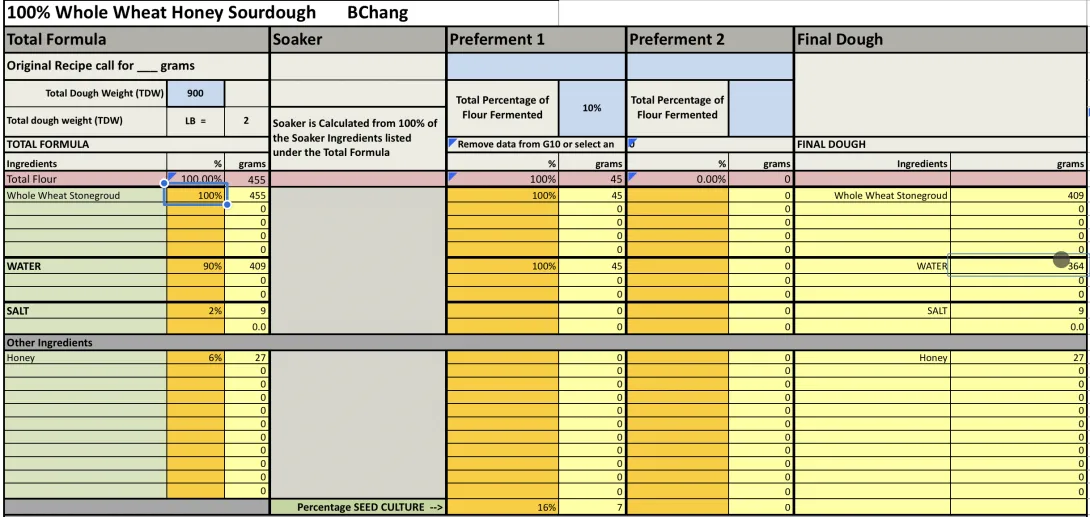
In the morning add levain to saltolyse dough, mix to incorporate with Rubaud mixing.
Slap and fold to good gluten development.
Rest 30 min then bench letterfold ferment at 82ºF removing 30 g of dough for aliquot jar
Rest 30 min then lamination
Then every 30 mins coil fold until dough showing good structure
End bulk when aliquot jar 60% rise
Shape then bench rest until aliquot jar 100% rise
Then cold retard until next day.
Next day
Preheat oven 500ºF with dutch oven inside.
Once over reaches temp, turn dough out of banneton, score and bake in dutch oven for 20 mins at 450ºF with lid on. Drop temperature to 420ºF and bake 10 mins with lid on.
Remove lid band bake for 20 mins or until done with the bread out of the dutch oven on rack directly.
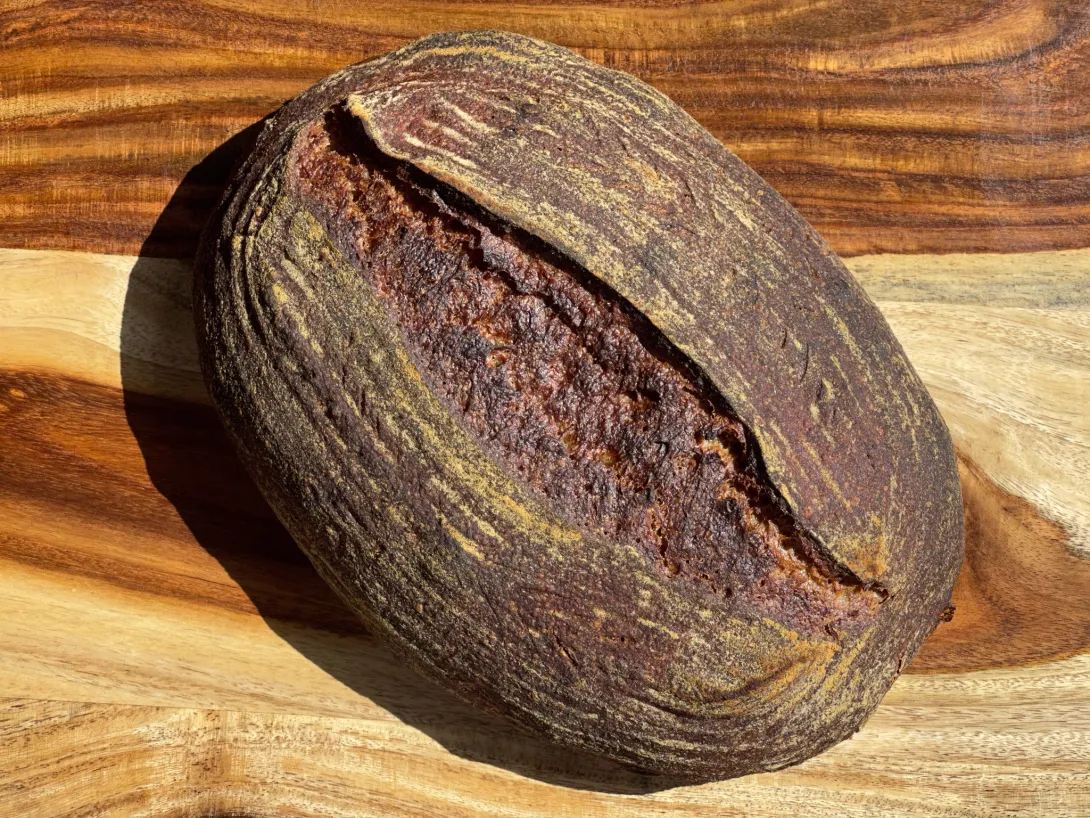
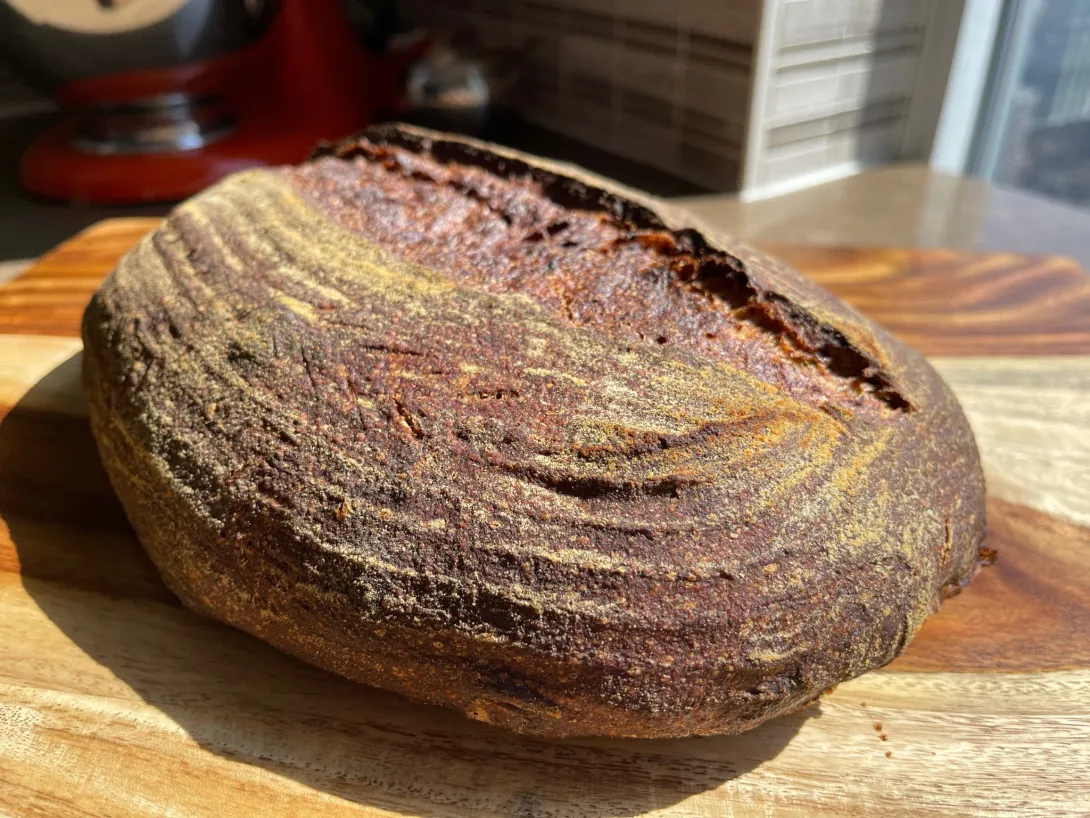
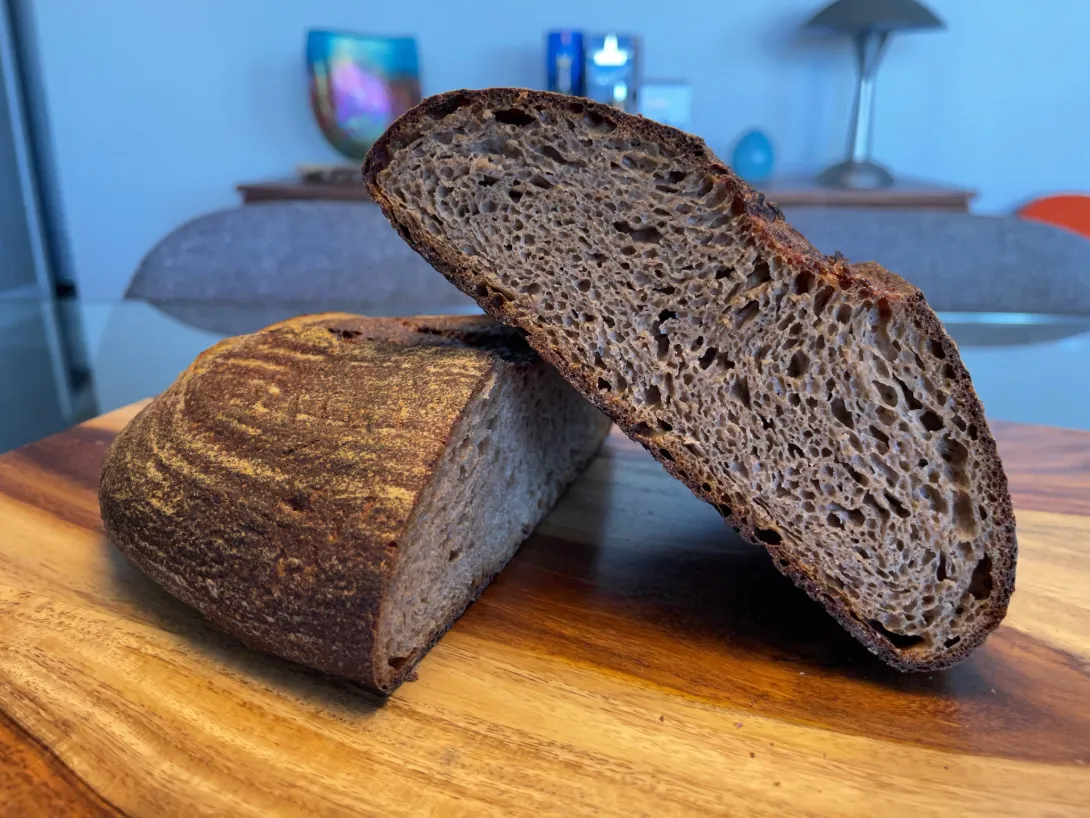
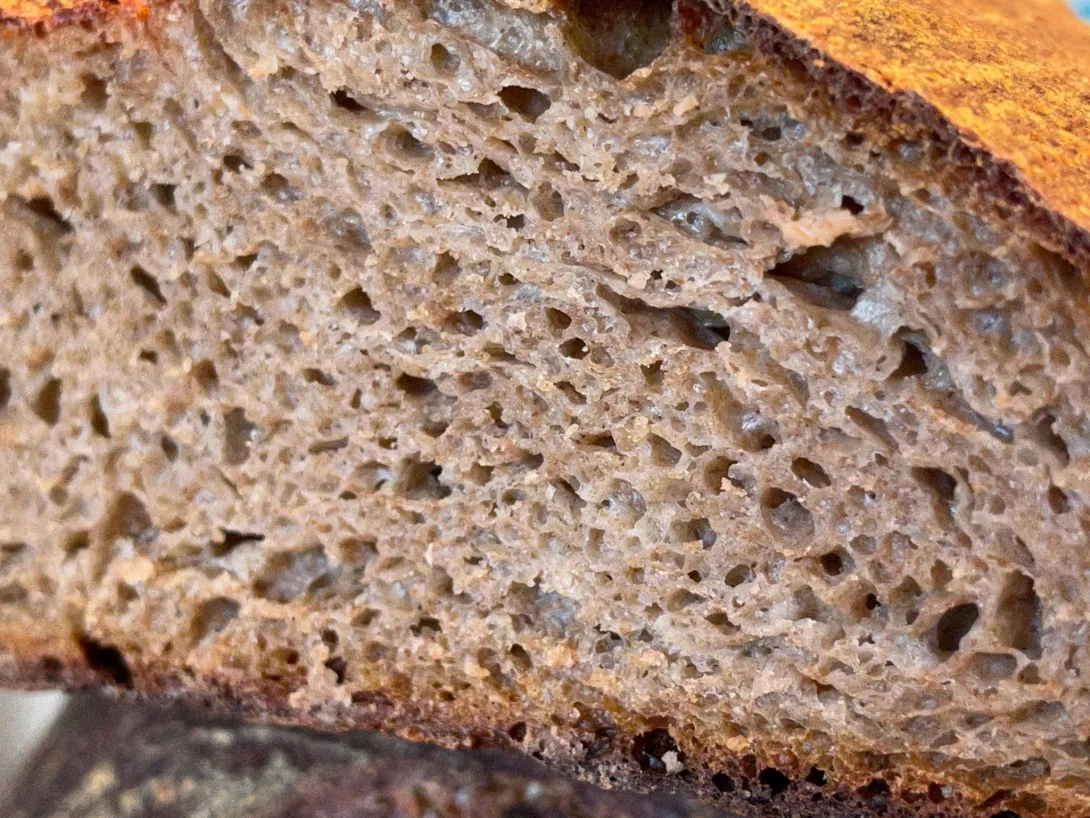
Not sure I will keep banging my head on the wall with doing 100% whole grain. Perhaps for me, doing 75-80% might be the sweet spot. That amount of whole grain certainly has the flavour and has been much more successful for me. On the other hand I hate calling it quits and not figuring something out so who knows.....
Anyhow, not my finest baking that’s for sure.
Benny
- Benito's Blog
- Log in or register to post comments
I'm sorry you aren't happy with your results here, I do think you're gaining some knowledge and experience though. Going back to our conversation yesterday it's possible that the overnight saltolyse is too much time for the whole grain to withstand the effects of proteolysis. But I'd still argue that the hydration is too high. That said, the crumb looks lovely and I have no doubt the texture is pleasant as well. If I were you I'd give it one last go at 75%, with maybe only an hour or so of autolyse. You could expect the dough to be very stiff and require very little coil folding with those numbers. But I would also encourage you to bake what you love, since that's why we do it! No need to bang heads against the wall, this should be fun.
Thanks for the suggestions and encouragement. After tasting this, I’m not fond of this particular whole wheat, I can’t put my finger on it, but something about the flavor is just a bit off. If and when I try again, I might consider going back to the red fife, at least with that, even if it comes out flat, it still tastes good. I definitely will drop the hydration and as you also suggest not use a saltolyse overnight. I’d start this levain early morning so hopefully I can shape in the evening. It takes out more of your day, but at least I could still have an autolyse. I’ll give it a pause for a bit before trying again. You are right though, it is all a learning experience and theoretically should benefit me in the long run.
Benny
Come on, this isn't something to quit over. :)
Just looks a tiny bit overproofed. Have you tried retarding it earlier?
I think I just need a break from these 100% whole grain bakes for a bit. And this new flour just doesn’t taste good to me. Perhaps blended in with other flours it might be fine, but I might be best in the bin. The birds might be getting this loaf as well.
What exactly about this loaf are you unhappy about? I see a beautiful even crumb, a nice oven spring and a really bold bake. For a lean,100%WW it looks great. Are you trying for big bubbles? Is the crumb too dry? Does it crumble? Is the off flavor from the dark bake?
After reading your spreadsheet and comments, I have some random thoughts.
I make enriched 100% WW sandwich bread so my bake is very different from yours. I start with a preheated oven to 450 and decrease it to 370 when I put it in the oven. Brown but not too bold a bake. Enriched,honey-sweetened, 100% WW,even crumb,good rise.
My dough is around 80% hydration for freshly ground hard red spring wheat.I use a Whispermill and get a pretty fine grind to my flour. My recipe calls for a preferment which I would make early in the day so it was ready by early evening. After dinner I would mix the preferment and all the final dough ingredients in the K5-mixed to windowpane. At times I've held the salt until the end of mixing as windowpane develops much quicker when that is done. Chemically, salt affects how water bonds to starch molecules. Starch hydrates much faster without salt. Then the dough goes into an oiled container. It rises for about 30-60 minutes on the counter to get started and then into the refrigerator for an overnight stay. By morning it is almost fully risen and has gone from sticky to tacky. I don't raise a natural levain WW 100%. Too often it seems to go proteolytic on me or go from fully proofed to overproofed in the blink of an eye. I usually shape after it reaches about 75%-not quite double. Even though the dough is cold, it doesn't seem to take long for the final proof.
When I've made my 100% WW sandwich loaf using Reinhart's Biga and soaker method, all the flour gets an overnight soak and then both biga and soaker are mixed together the next morning. Even at 80% hydraton, the dough is not as soft as you would think. Bulk ferment to 75%,shape/proof and bake at 375 for about 40 miinutes.
Writing this all down has helped me focus. Your comment about the flavor, the bulk fermentation to 100%,using fresh ground WW with natural levain are the key pieces of information,I believe. I'm of the opinion that you might try shortening the bulk fermentation and refrigerating when it is at 75%. I'm not so convinced the hydration is too high. It could be that the gluten is just a little too deteriorated to hold large air pockets. Simple enough to try.
Good luck-bake some delicious fun!
And for the same reasons. My 70-100% WW do come out with a tighter crumb, as expected, but that doesn't usually translate to a tough chew. Not anymore anyway, lol. ? I did need to learn to not expect big holes with the higher percent whole wheat. I have been milling hard white spring lately, and really like how that bakes. And glad you mentioned that Reinhart recipe, it's been a while since I did that one.....
Benny, hopefully you can find what tastes good to you. Maybe use that flour for something you take to work. Break room bread rarely lasts long, lol.
LOL such a good idea, never thought of that, thanks...
Benny
I feel a bit less down about that bake now that time has past and the initial disappointment has waned. I was hoping for a better oven spring, better bloom and a lighter crumb than achieved. I may have too high expectations for this and again I may have to adjust to that.
I don’t think the flavor is off because of the dark bake, the crumb alone isn’t to my liking, something about this new flour just isn’t to be taste I think.
Interesting that you don’t think that the hydration is necessarily too high. I do have to say that the dough felt really good and pretty strong during development. I think a common theme here from you bakers who are much more experienced with 100% whole grain bakes though is that the gluten in these doughs don’t seem to tolerate as much fermentation as doughs with less whole grain. That isn’t something that I would ever have expected and don’t recall reading anywhere before. But that will definitely be something to adjust. The bulk fermentation maybe fine at 50-60% aliquot jar rise, but then a much shorter initial bench proof before cold retard maybe a good strategy. Also, eliminating the long saltolyse as well sounds like a good idea.
As I’ve said, I’ll give this a break for a bit and come back around to trying again in the future.
Thank you for your thoughts and analysis.
Benny
I've never baked an 100% whole grain, as I'm not confident that I understand the underlying science. My reckoning so far is that the higher whole-grain content the denser the crumb, but I'm not sure how to lighten the dough to overcome the denseness. The crumb in your loaf looks very good to me. What would you do to overcome what you think are the issues with this one, and flavour development?
Cheers,
Gavin
Thanks for having a look at my bake Gavin. As I stated above, having the gluten in whole grain being less tolerant to long fermentation is a new concept to me and one I don’t understand the science of. However, more experienced bakers have told me this a couple of times now so that is something to address. No saltolyse, shorter autolyse, shorten bulk fermentation a bit and definitely less final proof before cold retard. Finally, I think I will decrease hydration a bit on my next bake of 100% whole grain. In terms of flavour, I’ll go back to whole red fife, I guess I’ve become accustomed to it and much prefer it to this whole wheat which really wasn’t anything special. If I’m going to eat a flat whole grain bread, it might as well have a flavor that I like.
Benny
Benny, I think your long autolyse to get the grain fully hydrated is on point. I see two main differences between what you do and this method (the one I've used successfully a few times now). [My flours (or my technique) can't handle 90% hydration, so I go with 80%]
https://www.thefreshloaf.com/node/67363/what-lovely-whole-wheat-sourdough-recipe
1) The long autolyse is refrigerated. Might slow down the enzyme activity? I just pull the dough out an hour or so before mixing, and then I stretch it fairly thin on the counter when I spread on my levain (80% hydration). This allows the dough to come up to temp before proofing.
2) Much less gluten development early in BF. Mild hand kneading and then bowl S&F. Your coil folds may give you a more open crumb. I tend to target a sandwich loaf crumb.
I think you're closer to a 100% whole grain bread than you think. ;-)
Once I feel up to it again I’ll need to decide what to change. For sure reducing the hydration is one thing. Despite there being perhaps a couple of things to change, logically I should only change one thing at a time, that would probably be the best thing to change first. A refrigerated autolyse would certainly slow the enzymes down very well and that would work without having to add the salt. Doing less slap and folds would certainly be easier on the baker!
Thanks Troy.
Benny
Don't change too much or you will really be disappointed. You just need some tweaks!
Whole wheat needs time to fully hydrate no matter the percentage.As little as 30 minutes can make a noticeable difference in crumb moisture. If the branny bits are not fully hydrated, they will continue to absorb the moisture from the crumb after the bake,drying the crumb. Next time you take a bite of your sandwich it crumbles in your hand. That is why any whole grain bread needs a good soak of some kind- biga, mix & forget, saltolyse, remix method, preferment, plain autolyse, sponge method, etc. Almost any method works just fine. A soak of some kind helps but it does not have to be prolonged. If it is a prolonged soak (my opinion is anything over 1-2 hrs,depending on ambient temp),then refrigerate.
Refrigeration for a long soak of some kind helps minimize the degradation by enzymes that can occur at warmer temps. Natural levain ferments and overferments WW faster than AP flour doughs. If it is a long soak, refrigerate it.
The other requirement for a high percentage WW dough is to develop the starchy gel in the dough to windowpane. Starchy gel is a term I have coined and comes from observation. Along with the gluten strands,the starchy gel that forms the main part of the crumb needs to be plentiful and well hydrated. That comes from adequate hydration, time and manipulation (kneading,folding,etc). WW dough has plenty of ability to form great gluten strands and great starchy gel but may require a little more coaxing. It sounds like you have that part down since you talk about the dough feeling strong.
So don't change too much. A little less bulk fermentation,a longer (refrigerated) soak of some kind,a little less final proof.
My best loaves used a preferment,mixed all dough to windowpane, refrigerated overnight (it usually rose to 75% in refrig), either warmed up for 30 min on counter or finished bulk on counter in am if I thought it needed more rise, shaped, short final proof,bake.
You really are almost there.